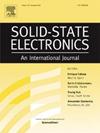基于斯坦福模型的基于氧化物的电阻随机存取存储单元编程的封闭模型
IF 1.4
4区 物理与天体物理
Q3 ENGINEERING, ELECTRICAL & ELECTRONIC
引用次数: 0
摘要
本文提出了一种基于脉冲编程的基于氧化物的电阻随机存取存储器器件的封闭模型。以斯坦福模型为基础,以封闭形式求解规划周期。这个溶液的温度是恒定的。通过封闭式模型,可以直接快速地计算出编程后器件的状态或实现特定器件电导所需的编程设置。斯坦福模型需要耗时的迭代计算以获得较高的瞬态分析精度,而这对于闭型模型来说是不必要的。封闭形式的模型可在不同的编程脉冲宽度和电压之间进行扩展。本文章由计算机程序翻译,如有差异,请以英文原文为准。
A closed-form model for programming of oxide-based resistive random access memory cells derived from the Stanford model
This paper presents a closed-form model for pulse-based programming of oxide-based resistive random access memory devices. The Stanford model is used as a basis and solved in a closed-form for the programming cycle. A constant temperature is set for this solution. With the closed-form model, the state of the device after programming or the required programming settings for achieving a specific device conductance can be calculated directly and quickly. The Stanford model requires time-consuming iterative calculations for high accuracy in transient analysis, which is not necessary for the closed-form model. The closed-form model is scalable across different programming pulse widths and voltages.
求助全文
通过发布文献求助,成功后即可免费获取论文全文。
去求助
来源期刊

Solid-state Electronics
物理-工程:电子与电气
CiteScore
3.00
自引率
5.90%
发文量
212
审稿时长
3 months
期刊介绍:
It is the aim of this journal to bring together in one publication outstanding papers reporting new and original work in the following areas: (1) applications of solid-state physics and technology to electronics and optoelectronics, including theory and device design; (2) optical, electrical, morphological characterization techniques and parameter extraction of devices; (3) fabrication of semiconductor devices, and also device-related materials growth, measurement and evaluation; (4) the physics and modeling of submicron and nanoscale microelectronic and optoelectronic devices, including processing, measurement, and performance evaluation; (5) applications of numerical methods to the modeling and simulation of solid-state devices and processes; and (6) nanoscale electronic and optoelectronic devices, photovoltaics, sensors, and MEMS based on semiconductor and alternative electronic materials; (7) synthesis and electrooptical properties of materials for novel devices.
 求助内容:
求助内容: 应助结果提醒方式:
应助结果提醒方式:


